MEMS Applications in the FA Equipment Industry
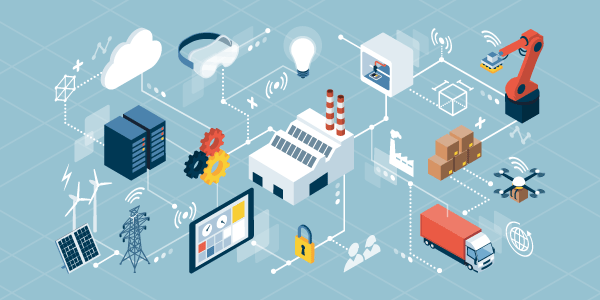
With the aim of further improving productivity, reducing costs, and reducing environmental impact, the trend toward smart factories is accelerating in the FA industry. To improve efficiency, data analysis through digitization has become essential, and sensors have become vital for acquiring such data.
Also, through the use of AI, sensors are playing an important role in failure prediction and autonomous control circuits for robots, which were considered difficult to achieve in the past, and high-accuracy MEMS sensors are expected to play an even greater role in coming years.
- Types and Roles of MEMS Sensors Used in FA Equipment
- MinebeaMitsumi’s MEMS Devices Utilized in the FA Equipment Industry
Types and Roles of MEMS Sensors Used in FA Equipment
In factories where FA equipment is used, a variety of sensors are used in product quality checks and in manufacturing equipment. Although not all sensors use MEMS technology, the range of its applications is expanding. For example, MEMS flow sensors are used to control air conditioning in factories to create a comfortable work environment and prevent malfunctions.
Also, in manufacturing lines, MEMS 6-axis force torque sensors and pressure sensors are used in industrial robots, and IR sensors are used to ensure safety.
MEMS Sensors for Smart Factories
A variety of sensors are used in factories for different purposes, such as controlling processes by sensing pressure, force, and images, and preventing breakdowns by detecting vibrations and sounds generated by equipment.
Various sensors also contribute to the creation of a safe work environment, such as gas sensors and LiDAR to protect the safety of factory workers.
Smart factories require more detailed and accurate information than was previously available. By using various sensors to acquire a variety of information in the factory and analyze the data, necessary measures can be taken to solve existing issues and achieve efficient manufacturing. As the manufacturing industry seeks to become more competitive in the global marketplace, sensors will play an even greater role in coming years.
MEMS sensors to manage air flow
In the manufacture of products and components, there are processes that manage the flow of air and liquids, and various types of flow sensors play an active role in these processes.
MEMS air direction sensors, a type of MEMS flow sensor, are used in cleanrooms to prevent the introduction of microscopic dust and bacteria in the air, and are used to manage air flow and temperature distribution in manufacturing processes that require environmental temperature control.
By visualizing air flow with MEMS flow sensors, dust that can cause product defects can be blocked and the environment within a factory or process can be kept at a constant level, which is useful for manufacturing high quality products and creating a comfortable work environment.
MEMS Sensors for Human Safety
Various sensors are used in factories to protect human safety. For example, sensors that detect hazards include gas sensors and optical sensors that stop machinery when a person enters a hazardous area.
MEMS sensors for detecting harmful gases
MEMS gas sensors detect gas concentrations that are unnoticeable to humans and sound an alert to warn of danger if the concentration exceeds a specified value.
While detection by such MEMS sensors is important, such sensors must be used in tandem with conventional sensors to insure optimal safety conditions in factories and workplaces.
MEMS devices used in automated vehicles
The automated guided vehicles (AGVs) used in factories are equipped with cameras, IR sensors, LiDAR, and other devices. Of these, MEMS devices are used in the IR sensors and LiDAR to measure the distance to surrounding obstacles and workers during automated driving for preventing collisions with them.
MEMS Sensors for Advanced Automation
Greater automation using various types of robots is being implemented in factories, but in the past, robots could only perform routine tasks. Today, however, MEMS devices can be used for enabling more advanced automation.
MEMS sensors used in air cylinders and grippers
The gripping operation in a factory or process may use compressed air from a compressor or a magnetic circuit such as a motor. Until now, grippers using compressed air have been widely used in the manufacturing process. However, air cylinders that use air can only open or close the gripper, and they cannot grip with a delicate degree of force.
The use of MEMS sensors enables fine control, making it possible for a robot to perform tasks such as gripping and sorting soft objects instead of using human workers.
Also, because compressors used in factories are generally large and require extensive equipment, electric grippers are being used more and more instead of those using compressed air.
Furthermore, suction-type robot hands (end effectors) that use small electric vacuum pumps and pressure sensors are also available now.
MinebeaMitsumi’s MEMS Devices Utilized in the FA Equipment Industry
MinebeaMitsumi has long supplied a wide range of products to the FA industry, including bearings, cooling fans, motors, and power supplies. Recently, in addition to these products, MinebeaMitsumi has also developed and manufactured MEMS pressure sensors and MEMS force torque sensors, and demand for devices made with MEMS technology is expected to grow further in coming years.
Miniature 6-axis Force Torque Sensor That Reproduces Human Sensation in a Robot
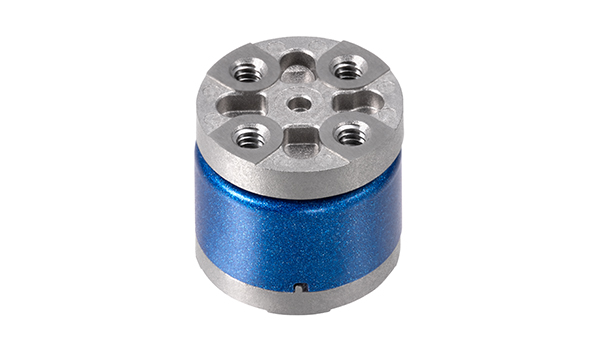
Force torque sensors in FA equipment are mounted on robot wrists and other parts to provide various force-sensing capabilities.
MinebeaMitsumi has developed a miniature 6-axis force torque sensor for use in robot hands and grippers.
MEMS technology is utilized to enable an ultra-compact force torque sensor with a ⌀9.6 mm × 9 mm size. The 6-axis sensor, which was previously only mounted on the wrist of a robot, can now also be mounted on a robot fingertip.
By mounting the sensor on the fingertip, the robot can directly sense the object to be gripped, thus enabling detailed detection of the force exerted on the position of the gripped object.
The miniaturization of the device makes it possible to use it as part of production equipment, and it can detect vibration and forces applied in equipment and manufacturing processes. Processes that previously relied on human senses can now be digitized numerically, helping to improve operations and increase efficiency.
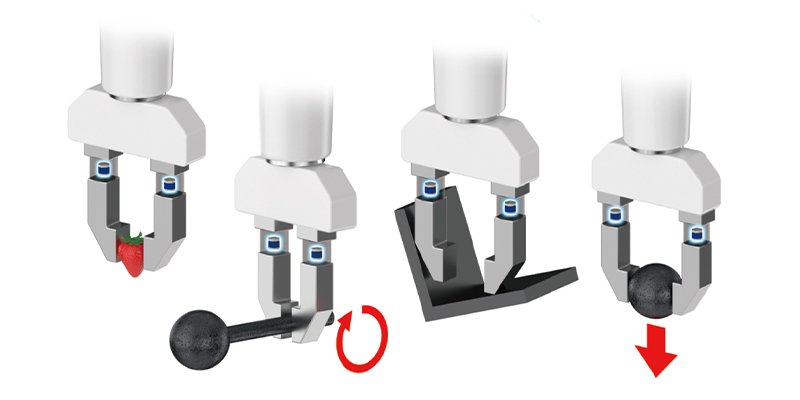
Flow Sensors for Controlling Air Flow in a Factory
Flow sensors are used to visualize flow rate and air velocity. Knowing the air flow not only makes the factory environment more comfortable, but also prevents unwanted dust from entering the production line.
MinebeaMitsumi’s MEMS flow sensor incorporates a ΔΣ type AD converter and a heater in the center of the MEMS. The amount of change in temperature distribution generated by heating the heater is converted into a voltage and the data is output digitally.
Since even the slightest air flow can be detected and used to control equipment, this enables energy savings by limiting use to only the necessary air volume.
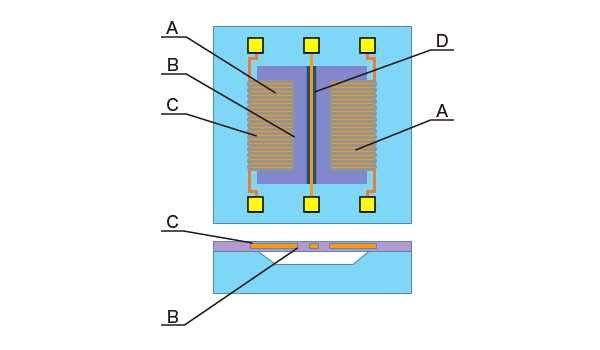
- A: Thermopile
- B: Warm contact
- C: Cold contact
- D: Heater
Pressure Sensors for Measuring Various Pressures
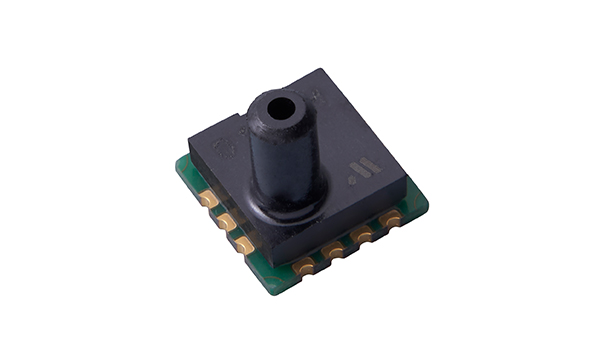
In the FA industry, MEMS pressure sensors are used to control the air pressure (gas pressure) and hydraulic pressure of equipment used in factories, and the measured information is used for performing the appropriate equipment operation.
Also, some robot hands are suction-type devices that utilize pressure, and MEMS pressure sensors enable fine control and handling without damaging the product that is gripped.
MinebeaMitsumi’s pressure sensors are used in the ways described above and also in a wide range of applications and FA equipment.
